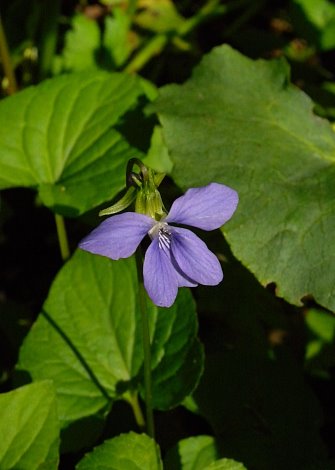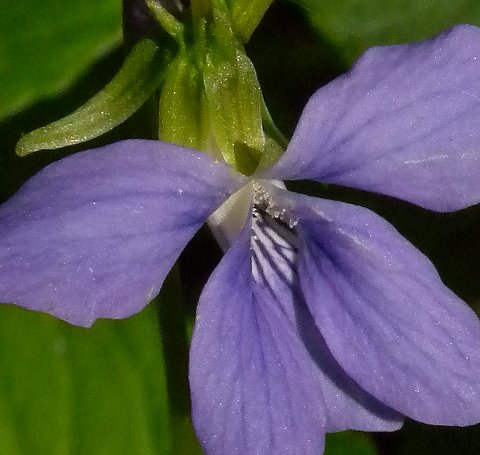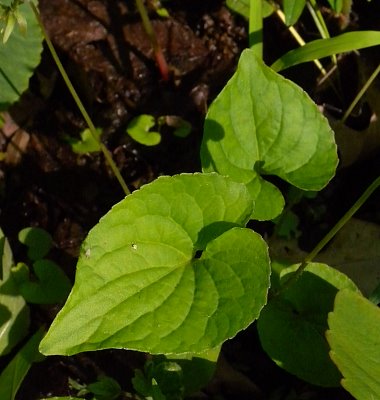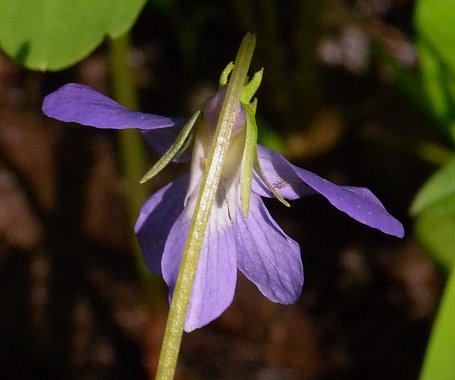
Solitary flowers are produced at the tips of pedicels up to 7" long. The erect to ascending pedicels are light green to light purplish green and glabrous. Each flower is about ¾" across, consisting of 5 medium to dark blue-violet petals (rarely white), 5 light green sepals, and the reproductive organs. The petals are elliptic-obovate in shape and about twice the length of the sepals. The 2 lateral petals have short white hairs with swollen tips near the throat of the flower. The lowermost petal has a patch of white with radiating purple veins in the front, while in the back it has a short stout nectar spur. The sepals are linear-lanceolate and glabrous; they usually have pointed auricles (eared basal lobes) up to 4 mm. long. The blooming period occurs from mid- to late spring for about 1 month. Afterwards, successfully fertilized flowers are replaced by seed capsules about ½" long that are light green and ovoid-oblongoid in shape. In addition to these flowers, cleistogamous (self-fertile) flowers are produced that lack showy petals. The cleistogamous flowers are produced on ascending pedicels during the summer. At maturity, the capsules of both types of flowers split open into 3 sections, to eject their seeds. Individual seeds are about 2.5 mm. in length, globoid in shape, and dark-colored. The root system consists of a crown with fibrous roots and rhizomes.

Cultivation: The preference is full sun to light shade, wet to moist conditions, and soil containing loam, silty loam, or sandy loam with organic matter.
Range & Habitat: The native Marsh Violet is occasional in NE Illinois, while the in the rest of the state it is uncommon or absent (see Distribution Map). Habitats include marshes, bogs, swamps, seeps, and borders of rocky streams. This violet is found in both sandy and non-sandy wetlands in both shaded and unshaded areas.

Faunal Associations: The floral nectar of Marsh Violet attracts bumblebees, mason bees (Osmia spp.), Halictid bees, Andrenid bees, bee flies (Bombyliidae), butterflies, and skippers (Robertson, 1929). Some of the bees also collect pollen. An oligolectic bee, Andrena violae, visits the flowers of Marsh Violet and other Viola spp. (violets). The caterpillars of several Fritillary butterflies feed on the foliage of violets primarily in open areas: Boloria bellona (Meadow Fritillary), Boloria selene myrina (Silver-Bordered Fritillary), Euptoieta claudia (Variegated Fritillary), Speyeria aphrodite (Aphrodite Fritillary), Speyeria atlantis (Atlantis Fritillary), Speyeria cybele (Great Spangled Fritillary), and Speyeria idalia (Regal Fritillary). Other insect feeders include caterpillars of the moths Elaphria grata (Grateful Midget) and Eubaphe mendica (The Beggar), the leaf-mining larvae of Ametastegia pallipes (Violet Sawfly), the aphid Neotoxoptera violae, and the thrips Odontothrips pictipennis. The seeds and other parts of violets are occasionally eaten by such birds as the Ruffed Grouse, Wild Turkey, and Mourning Dove, and they are also consumed by the White-Footed Mouse, Pine Mouse, and Eastern Chipmunk. Similarly, the foliage of these low-growing plants is a source of food for the Cottontail Rabbit and Wood Turtle (Clemmys insculpta).
Photographic Location: A sandy swamp at the Indiana Dunes State Park in NW Indiana.

Comments: At first glance, the Marsh Violet can be easily confused with the Common Blue Violet (Viola pratincola) and other rosette-forming violets (Viola spp.) with blue-violet flowers. It can be distinguished from these other species, however, by the club-shaped hairs on its lateral petals (a 10x hand lens may be required to see this). The hairs of lateral petals on other violets are usually filiform (thread-like) and rarely possess conspicuous swollen tips. The only other violet in Illinois that has such hairs on its lateral petals is the rare Wayside Violet (Viola viarum). This latter species is easily distinguished from the Marsh Violet by its lobed leaves and its preference for dry habitats. Across its range, the Marsh Violet is rather variable in such characteristics as the shade of blue-violet on its petals, the shape of its leaves, the presence or absence of pointed auricles (eared basal lobes) on its sepals, and the extent to which the flowers are held above the foliage. Although different varieties of the Marsh Violet have been described in other parts of North America, none of these are currently recognized in Illinois. The scientific name, Viola obliqua, is considered a synonym of this species.